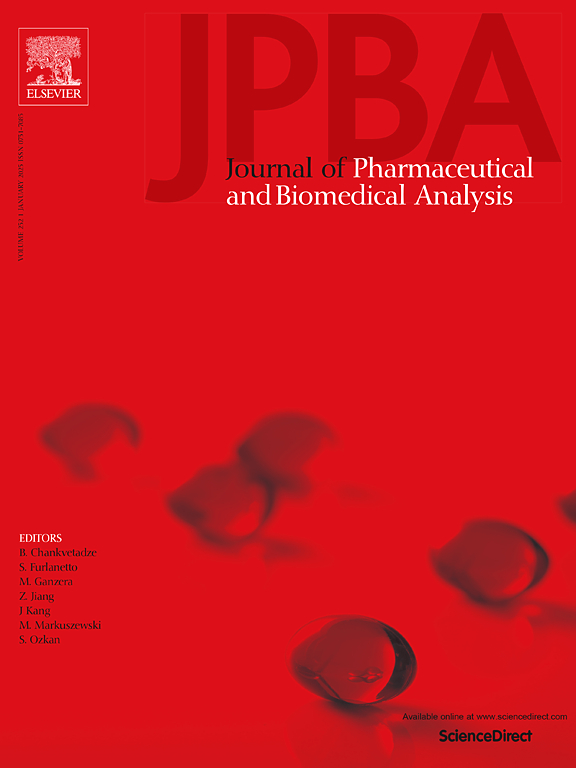基于随机森林模型的LC-MS和NMR数据融合策略在大黄素肝毒性代谢组学研究中的应用
IF 3.1
3区 医学
Q2 CHEMISTRY, ANALYTICAL
Journal of pharmaceutical and biomedical analysis
Pub Date : 2025-05-27
DOI:10.1016/j.jpba.2025.116990
引用次数: 0
摘要
数据融合是将来自不同检测源的数据矩阵整合成一个综合模型的过程,可以更全面地挖掘样本的特征,为获得更准确的分类提供可能。在我们之前的研究中,我们使用液相色谱-质谱(LC-MS)和核磁共振(NMR)技术研究了大黄素给药前后的肝脏代谢组学。但不同给药时间的大黄素组间的分类效果并不理想。本研究采用主成分分析、偏最小二乘判别分析、支持向量机、k近邻、神经网络、决策树和随机森林(RF)算法构建低级(LLDF)和中级(MLDF)数据融合模型。单个数据集和LLDF的模型分类效果都较差,而MLDF模型的分离效果明显提高,其中结合RF模型选择的特征建立的RF模型(RF-RF)分类效果最好。本研究首次将LC-MS和NMR数据融合技术应用于大黄素肝毒性代谢组学研究,更全面、更深入地探索其差异代谢物,为后续机制研究提供研究基础。本文章由计算机程序翻译,如有差异,请以英文原文为准。
A novel data fusion strategy of LC-MS and NMR technologies using random forest model for emodin hepatotoxic metabolomics research
Data fusion is a process of integrating data matrices from different detection sources into a comprehensive model, which can more comprehensively mine the characteristics of samples and provide the possibility of obtaining more accurate classification. In our previous study, liquid chromatography-mass spectrometry (LC-MS) and nuclear magnetic resonance (NMR) techniques were used to investigate liver metabolomics before and after emodin administration. However, the classification effect between groups of emodin with different durations of administration was not ideal. In this study, principal component analysis, partial least squares discrimination analysis, support vector machine, k-nearest neighbor, neural network, decision tree, and random forest (RF) algorithms were applied for building low-level (LLDF) and mid-level data fusion (MLDF) models. The model classification effects of both the single data set and LLDF were poor, while the separation effect of the MLDF model was significantly improved, among which an RF model established after combining the features selected by the RF model (RF-RF) had the best classification effect. This was the first study to apply LC-MS and NMR data fusion techniques to emodin hepatotoxic metabolomics research, to explore the differential metabolites at a more comprehensive and deeper level, and to provide a research basis for subsequent mechanism studies.
求助全文
通过发布文献求助,成功后即可免费获取论文全文。
去求助
来源期刊
CiteScore
6.70
自引率
5.90%
发文量
588
审稿时长
37 days
期刊介绍:
This journal is an international medium directed towards the needs of academic, clinical, government and industrial analysis by publishing original research reports and critical reviews on pharmaceutical and biomedical analysis. It covers the interdisciplinary aspects of analysis in the pharmaceutical, biomedical and clinical sciences, including developments in analytical methodology, instrumentation, computation and interpretation. Submissions on novel applications focusing on drug purity and stability studies, pharmacokinetics, therapeutic monitoring, metabolic profiling; drug-related aspects of analytical biochemistry and forensic toxicology; quality assurance in the pharmaceutical industry are also welcome.
Studies from areas of well established and poorly selective methods, such as UV-VIS spectrophotometry (including derivative and multi-wavelength measurements), basic electroanalytical (potentiometric, polarographic and voltammetric) methods, fluorimetry, flow-injection analysis, etc. are accepted for publication in exceptional cases only, if a unique and substantial advantage over presently known systems is demonstrated. The same applies to the assay of simple drug formulations by any kind of methods and the determination of drugs in biological samples based merely on spiked samples. Drug purity/stability studies should contain information on the structure elucidation of the impurities/degradants.

 求助内容:
求助内容: 应助结果提醒方式:
应助结果提醒方式:


